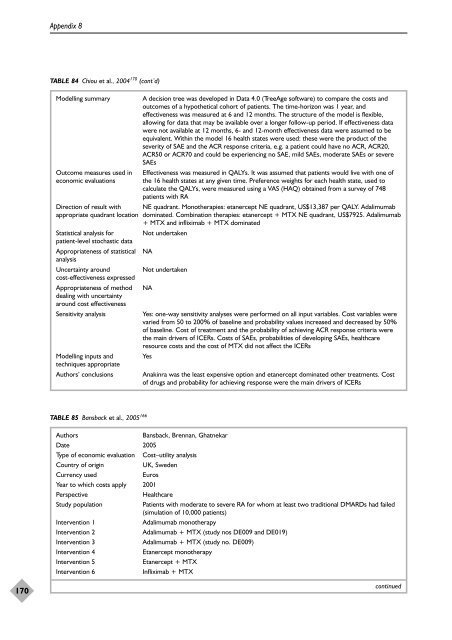A systematic review of the effectiveness of adalimumab
A systematic review of the effectiveness of adalimumab
A systematic review of the effectiveness of adalimumab
You also want an ePaper? Increase the reach of your titles
YUMPU automatically turns print PDFs into web optimized ePapers that Google loves.
170<br />
Appendix 8<br />
TABLE 84 Chiou et al., 2004 170 (cont’d)<br />
Modelling summary A decision tree was developed in Data 4.0 (TreeAge s<strong>of</strong>tware) to compare <strong>the</strong> costs and<br />
outcomes <strong>of</strong> a hypo<strong>the</strong>tical cohort <strong>of</strong> patients. The time-horizon was 1 year, and<br />
<strong>effectiveness</strong> was measured at 6 and 12 months. The structure <strong>of</strong> <strong>the</strong> model is flexible,<br />
allowing for data that may be available over a longer follow-up period. If <strong>effectiveness</strong> data<br />
were not available at 12 months, 6- and 12-month <strong>effectiveness</strong> data were assumed to be<br />
equivalent. Within <strong>the</strong> model 16 health states were used: <strong>the</strong>se were <strong>the</strong> product <strong>of</strong> <strong>the</strong><br />
severity <strong>of</strong> SAE and <strong>the</strong> ACR response criteria, e.g. a patient could have no ACR, ACR20,<br />
ACR50 or ACR70 and could be experiencing no SAE, mild SAEs, moderate SAEs or severe<br />
SAEs<br />
Outcome measures used in Effectiveness was measured in QALYs. It was assumed that patients would live with one <strong>of</strong><br />
economic evaluations <strong>the</strong> 16 health states at any given time. Preference weights for each health state, used to<br />
calculate <strong>the</strong> QALYs, were measured using a VAS (HAQ) obtained from a survey <strong>of</strong> 748<br />
patients with RA<br />
Direction <strong>of</strong> result with NE quadrant. Mono<strong>the</strong>rapies: etanercept NE quadrant, US$13,387 per QALY. Adalimumab<br />
appropriate quadrant location dominated. Combination <strong>the</strong>rapies: etanercept + MTX NE quadrant, US$7925. Adalimumab<br />
+ MTX and infliximab + MTX dominated<br />
Statistical analysis for Not undertaken<br />
patient-level stochastic data<br />
Appropriateness <strong>of</strong> statistical NA<br />
analysis<br />
Uncertainty around Not undertaken<br />
cost-<strong>effectiveness</strong> expressed<br />
Appropriateness <strong>of</strong> method NA<br />
dealing with uncertainty<br />
around cost <strong>effectiveness</strong><br />
Sensitivity analysis Yes: one-way sensitivity analyses were performed on all input variables. Cost variables were<br />
varied from 50 to 200% <strong>of</strong> baseline and probability values increased and decreased by 50%<br />
<strong>of</strong> baseline. Cost <strong>of</strong> treatment and <strong>the</strong> probability <strong>of</strong> achieving ACR response criteria were<br />
<strong>the</strong> main drivers <strong>of</strong> ICERs. Costs <strong>of</strong> SAEs, probabilities <strong>of</strong> developing SAEs, healthcare<br />
resource costs and <strong>the</strong> cost <strong>of</strong> MTX did not affect <strong>the</strong> ICERs<br />
Modelling inputs and Yes<br />
techniques appropriate<br />
Authors’ conclusions Anakinra was <strong>the</strong> least expensive option and etanercept dominated o<strong>the</strong>r treatments. Cost<br />
<strong>of</strong> drugs and probability for achieving response were <strong>the</strong> main drivers <strong>of</strong> ICERs<br />
TABLE 85 Bansback et al., 2005 166<br />
Authors Bansback, Brennan, Ghatnekar<br />
Date 2005<br />
Type <strong>of</strong> economic evaluation Cost–utility analysis<br />
Country <strong>of</strong> origin UK, Sweden<br />
Currency used Euros<br />
Year to which costs apply 2001<br />
Perspective Healthcare<br />
Study population Patients with moderate to severe RA for whom at least two traditional DMARDs had failed<br />
(simulation <strong>of</strong> 10,000 patients)<br />
Intervention 1 Adalimumab mono<strong>the</strong>rapy<br />
Intervention 2 Adalimumab + MTX (study nos DE009 and DE019)<br />
Intervention 3 Adalimumab + MTX (study no. DE009)<br />
Intervention 4 Etanercept mono<strong>the</strong>rapy<br />
Intervention 5 Etanercept + MTX<br />
Intervention 6 Infliximab + MTX<br />
continued
















